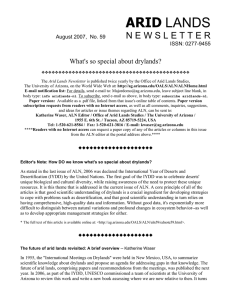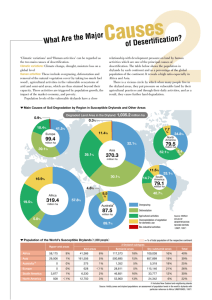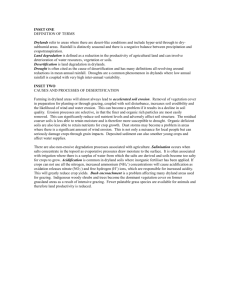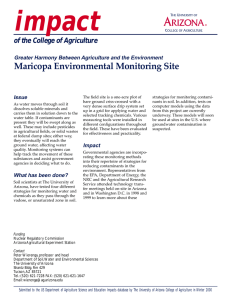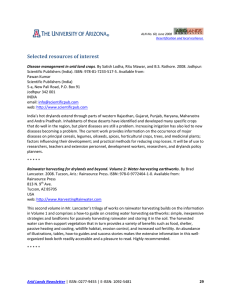ARID N E W S L E T T E R
advertisement
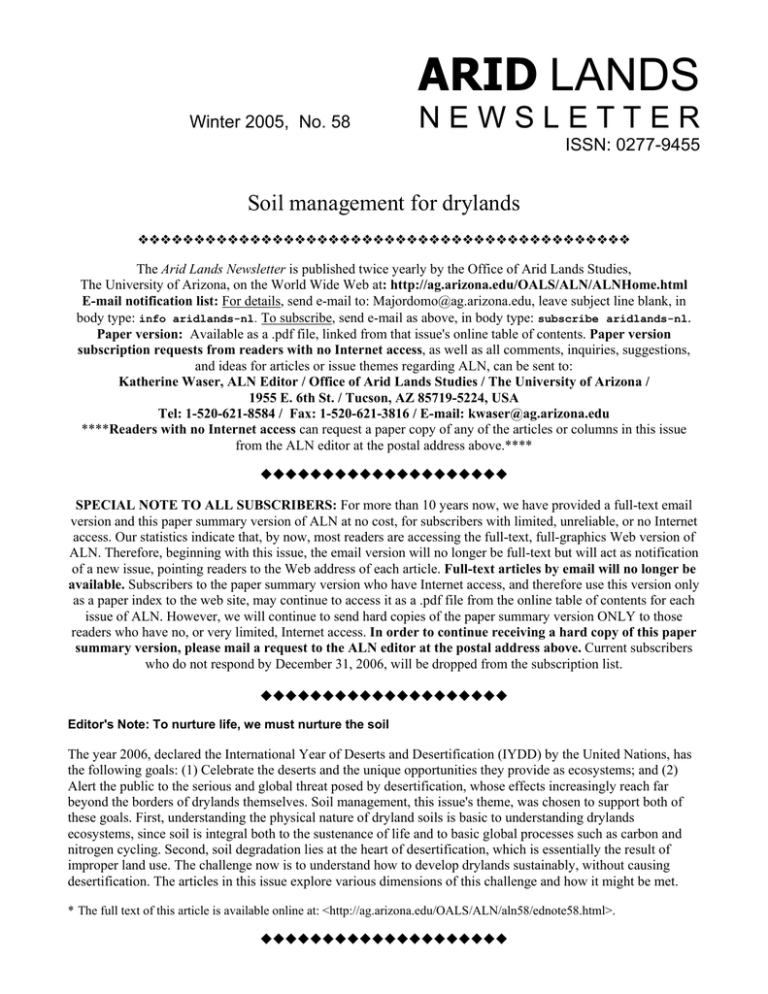
ARID LANDS Winter 2005, No. 58 NEWSLETTER ISSN: 0277-9455 Soil management for drylands The Arid Lands Newsletter is published twice yearly by the Office of Arid Lands Studies, The University of Arizona, on the World Wide Web at: http://ag.arizona.edu/OALS/ALN/ALNHome.html E-mail notification list: For details, send e-mail to: Majordomo@ag.arizona.edu, leave subject line blank, in body type: info aridlands-nl. To subscribe, send e-mail as above, in body type: subscribe aridlands-nl. Paper version: Available as a .pdf file, linked from that issue's online table of contents. Paper version subscription requests from readers with no Internet access, as well as all comments, inquiries, suggestions, and ideas for articles or issue themes regarding ALN, can be sent to: Katherine Waser, ALN Editor / Office of Arid Lands Studies / The University of Arizona / 1955 E. 6th St. / Tucson, AZ 85719-5224, USA Tel: 1-520-621-8584 / Fax: 1-520-621-3816 / E-mail: kwaser@ag.arizona.edu ****Readers with no Internet access can request a paper copy of any of the articles or columns in this issue from the ALN editor at the postal address above.**** SPECIAL NOTE TO ALL SUBSCRIBERS: For more than 10 years now, we have provided a full-text email version and this paper summary version of ALN at no cost, for subscribers with limited, unreliable, or no Internet access. Our statistics indicate that, by now, most readers are accessing the full-text, full-graphics Web version of ALN. Therefore, beginning with this issue, the email version will no longer be full-text but will act as notification of a new issue, pointing readers to the Web address of each article. Full-text articles by email will no longer be available. Subscribers to the paper summary version who have Internet access, and therefore use this version only as a paper index to the web site, may continue to access it as a .pdf file from the online table of contents for each issue of ALN. However, we will continue to send hard copies of the paper summary version ONLY to those readers who have no, or very limited, Internet access. In order to continue receiving a hard copy of this paper summary version, please mail a request to the ALN editor at the postal address above. Current subscribers who do not respond by December 31, 2006, will be dropped from the subscription list. Editor's Note: To nurture life, we must nurture the soil The year 2006, declared the International Year of Deserts and Desertification (IYDD) by the United Nations, has the following goals: (1) Celebrate the deserts and the unique opportunities they provide as ecosystems; and (2) Alert the public to the serious and global threat posed by desertification, whose effects increasingly reach far beyond the borders of drylands themselves. Soil management, this issue's theme, was chosen to support both of these goals. First, understanding the physical nature of dryland soils is basic to understanding drylands ecosystems, since soil is integral both to the sustenance of life and to basic global processes such as carbon and nitrogen cycling. Second, soil degradation lies at the heart of desertification, which is essentially the result of improper land use. The challenge now is to understand how to develop drylands sustainably, without causing desertification. The articles in this issue explore various dimensions of this challenge and how it might be met. * The full text of this article is available online at: <http://ag.arizona.edu/OALS/ALN/aln58/ednote58.html>. Saline and sodic soil management in irrigated crop production systems -- Jeffrey Silvertooth In drylands, the study of arid and salt-affected soils is a particularly important topic for land and water management, as indeed it has been throughout the history of agricultural development. Soil salinity and sodicity are natural components of desert agricultural systems and have plagued many attempts at developing and maintaining crop production systems in arid regions.The first step in developing appropriate management schemes for such conditions involves proper identification. This article describes the basic means for identifying such soils and briefly outlines the methods required to correct these conditions. *The full text of this article is available online at: <http://ag.arizona.edu/OALS/ALN/aln58/silvertooth.html>. Soil carbon and microbial biomass carbon after 40 years of grazing exclusion in semiarid sagebrush steppe of Wyoming -- Gyami Shrestha, Peter D. Stahl, Larry C. Munn, Elise G. Pendall, George F. Vance and Renduo Zhang Four grazing exclosures located in Wyoming sagebrush grasslands were studied between 2003 and 2005 to examine the effect of more than 40 years of grazing exclusion on soil organic carbon and soil microbial biomass carbon. Analysis of soil at two depths (0-5 cm and 5-15 cm) and from under three microsites – sagebrush, grasses and bare interspaces – was done inside and outside the grazing exclosures. Results showed some significant differences in carbon content and microbial biomass carbon concentrations according to treatments (grazed and non-grazed), microsites and/or depths of sampling. Significant interactions among these factors, influencing the studied soil parameters, were also observed. Greater microbial biomass carbon was observed inside three exclosures where grazing was excluded. One exclosure had greater organic carbon accumulation due to grazing exclusion. These results suggest that long-term grazing exclusion may have an effect in enhancing SOC sequestration in Wyoming sagebrush grasslands. *The full text of this article is available online at: <http://ag.arizona.edu/OALS/ALN/aln58/shrestha.html>. The potential for organic farming in the drylands of India -- Arun K. Sharma In India's pre-independence era (before the 1950s), agriculture was a system of harnessing nature for the sustenance of human beings, similar to the presently defined organic farming. Following independence, rapid population growth placed great pressure on these traditional farming systems; huge demands for food grains led to increased use of fertilizers and pesticides, which greatly boosted production. Unfortunately, these production increases have been accompanied by gradual and negative side effects; consequently, interest in organic agriculture is growing at both national and global levels. Organic agriculture is indeed being pursued in India; the National Programme of Organic Products (NPOP) was launched in 2000. However, this initiative is aimed largely at the export market, using intensive agriculture practices imappropriate for drylands, where land degradation, lack of local food security, and limited employment opportunities are already a serious issue. Meanwhile, soil and climate conditions in India's drylands make them particularly well suited to organic agriculture. This article details, first, the numerous ways in which the Indian drylands and organic agriculture are a good fit for each other; and second, several steps that should be taken to help promote this development. *The full text of this article is available online at: <http://ag.arizona.edu/OALS/ALN/aln58/sharma.html>. "Our carbon is gone; we have to bring it back!": Soil fertility management and social learning in Senegal's drylands -- Petra Tschakert Carbon sequestration projects in dryland farming systems are commonly based on two essential premises: first, that "improved" management practices are needed in order to sequester more carbon than under current systems; and, second, that local land managers, usually farmers and herders, need to be "made aware" of such enhanced options in order to initiate the necessary shift from one practice to another and achieve expected program outcomes. In sub-Saharan Africa, neither of these premises appears to seriously consider local land users as active and knowledgeable agents whose management rationales may prove of value to potential projects. And yet, while researchers, scientists, and policy makers are likely the ones to elect "best" practices, it is individual land owners and managers who will decide whether or not to implement them. Ignoring these individuals' viewpoints and rationales, therefore, seems a luxury we can ill afford. This article does not deny the fact that land degradation and soil fertility losses in drylands exist and that local knowledge to resolve them can be incomplete or even erroneous. Rather, it adopts a model of knowledge partnerships that merges expert opinion and local environmental wisdom to facilitate sustainable soil management decisions. Specifically, it demonstrates how Sahelian land managers can play an active role in a social learning process that puts carbon sequestration in the center of existing conceptual frameworks of soil fertility management in a way that is understandable and useful to agricultural decision-making. The lessons learned by the author and others from 14 months of carbon sequestration research with small-scale farmers in Senegal suggest that participatory approaches can be a valuable tool for collective learning and problem solving that serve the needs of community-based soil management in drylands. *The full text of this article is available online at: <http://ag.arizona.edu/OALS/ALN/aln58/tschakert.html>. Columns: Selected news of interest Selected resources of interest The following news items are briefly noted in this issue's columns: • • Nominations sought for 2006 PRODWAT Case Study Award Upcoming conferences of interest/Calls for papers • Deserts and Desertification: Challenges and Opportunities, 6-9 November 2006, Sede Boqer, Israel • III International Congress on cochineal and natural dyes [III Congreso Internacional de grana cochinilla y colorantes naturales], 13-17 November 2006, Morelia, Mexico • Climate Change and the Middle East: Past, present and future, 20-23 November 2006, Istanbul, Turkey • International Symposium on Drylands Ecology and Human Security: Regional Perspectives, Policy Responses and Sustainable Development in the Arab Region Challenges and Opportunities, 4-7 December 2006, Dubai • 3rd Future Environmental Trends Conference: Energy, Environment, and Development - Analysing Opportunities for Reducing Poverty, 14-16 December 2006, Bangalore, India Brief reviews of the following books are included in this issue's columns: • Rainwater harvesting for drylands. Volume 1: Guiding principles to welcome rain into your life and landscape, by Brad Lancaster. • Adaptive governance and water conflict: New institutions for collaborative planning, edited by John T. Schoz and Bruce Stiftel. • Changing faunal ecology in the Thar Desert, edited by B. K. Tyagi and Q. H. Baqri. • Monitoring manual for grassland, shrubland & savanna ecosystems, by J. Herrick, J. W. Van Zee, K. M. Havstad, L. M. Burkett and W. G. Whitford. ☛The full text of the news column is available online at: <http://ag.arizona.edu/OALS/ALN/aln58/news58.html>. The full text of the book review column is available online at: <http://ag.arizona.edu/OALS/ALN/aln58/books58.html> CALL FOR PAPERS: Arid Lands Newsletter No. 59 The year 2006 has been declared the International Year of Deserts and Desertification (IYDD) by the United Nations. The next issue of the Arid Lands Newsletter (No. 59, Winter 2006) will focus on an exploration of the twin themes declared for the IYDD: 1. The unique opportunities deserts provide as ecosystems, and 2. the serious and global threat posed by desertification. For this issue we are seeking articles that explore some aspect of the current "state of the art" regarding: • • Our understanding of dryland ecosystems (deserts, rangelands, dry woodlands) and their functioning. Effective strategies for combating desertification and increasing resilience of local communities, both: in the short term (e.g. diversifying livelihood strategies, sharing knowledge and appropriate technologies); and in the long-term (e.g. developing policies and institutional mechanisms to promote sustainable land use). As this theme covers quite a bit of territory, both broad overviews, and more narrowly focused papers detailing specific research or case studies, are welcome. Proposals for papers, comments, suggestions for possible authors, suggestions for resources (web, paper, CDROM etc.) to be included, etc. in either of these issues, are welcome. Please send your suggestions to Katherine Waser, Editor, Arid Lands Newsletter.
